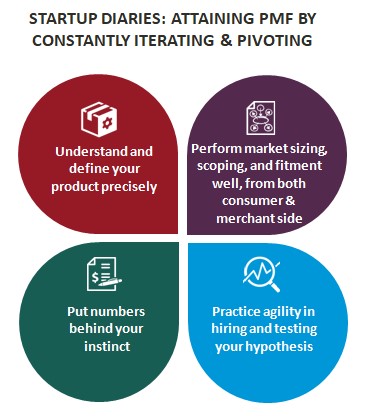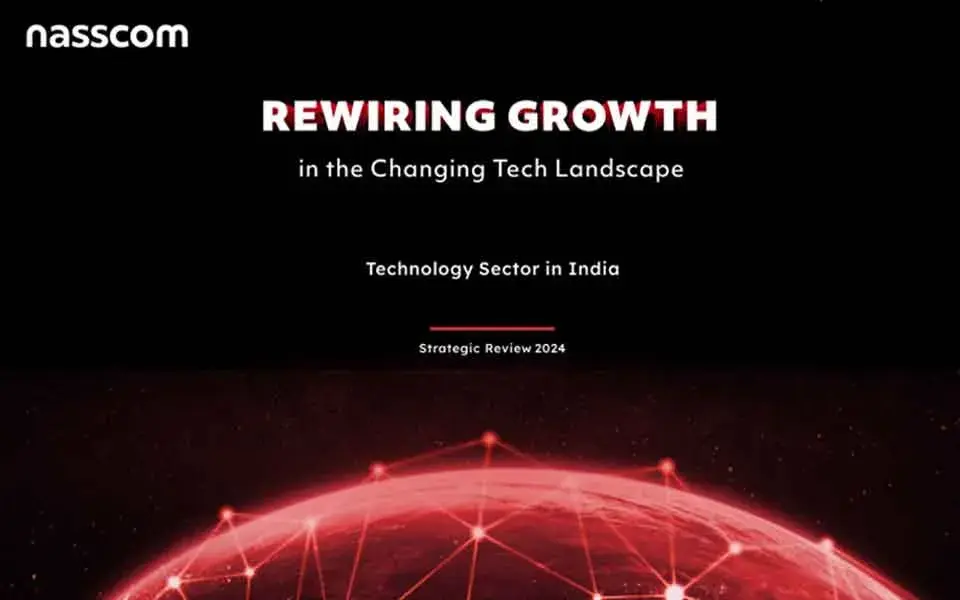An intriguing, candid conversation between Rajan Anandan, Managing Director, Sequoia Capital, and Suchita Salwan, Founder & CEO, Little Black Book (LBB) at NASSCOM Technology and Leadership Forum (NTLF) held in February 2022, gave us a sneak peek into the fascinating world of millennial buying behaviour and busted certain myths about e-commerce being a ‘winner-takes-all’ market and diversity in organizations.
The captivating journey of how the quintessential Delhi millennial in Suchita turned her passion for discovering her city, and inquisitiveness of the long-tail of local, starting with a Tumblr blog capturing interesting places to visit in India’s capital city, to setting up her own enterprise in 2015, with multiple pivots in the last 7 years, is one that has multiple key business lessons for startups and established enterprises alike. In essence, a unique information and product/brand marketplace, LBB is a discovery-led platform for consumers to come across and shop from India’s independent brands/businesses. Catering to ~2 million millennials on the web & app platforms, in addition to touch basing with about 50 million millennials every month through their social media outreach, LBB provides a platform for its users to browse through product recommendations for over 60,000 emerging brands/businesses, and shop from nearly 4,000 of them through the web & app platforms.
Small enterprises form the backbone of India’s business sector
Delving deep into India’s small business segment reveals an enormous long-tail of upcoming brands, especially within the lifestyle category, having a wide variety of novel, creative and indigenous products, but lacking the resources/reach to market those products. LBB acted as the bridge that connected these creators to their consumers, by democratizing the discovery of budding brands for the potential millennial market. Thus, by marrying the two worlds of established and emerging merchants and young users, LBB created a niche for itself. Mentioned below are some key insights that, if pursued, will stand early-stage founders in good stead:
- Iterate and Pivot until you attain Product-Market fit (PMF)
At times, pivoting can also be an extension of problem-solving in innovative ways, by adapting to rapidly changing consumer behaviour and mining a greater number of user-data points. For instance, when LBB set-up shop in 2015, tracking deliveries in the absence of companies like Shiprocket, Xpressbees, etc., was a daunting task. Moreover, business marketing through social media platforms such as Instagram was in its nascent stages. Therefore, the approach LBB adopted was to clearly define their problem statement and target market, as well as cope with new realities that got uncovered along the way, while solving existing issues.
Also, for early-stage companies, in order to attain PMF, it is critical to understand and define your product precisely. Illustratively, LBB started as a Tumblr blog, and then evolved into a website and later, an app. So while the product for LBB would seemingly be an app, in reality, it is the great recommendations and trustworthy information regarding products, brands, and businesses that the platform collates. Similarly, while Amazon operates through a website and an app, their broader investments are towards ensuring that the products on their platform reach the consumer quicker, in good shape, and at cheaper rates than any other marketplace. Hence, early-stage founders need to be wary of not defining their product as the interface between their company and the consumer, and clearly outlining what their product is, focusing more on their product positioning/brand recall in the consumers’ mind, without getting overly concerned about the product technicalities.
Equally important, is understanding market fitment not only from the consumer side, but the merchant side as well, in terms of clearly scoping the locations/geographies for your products/services, studying the market size, scalability, current incumbents, potential competitors, etc.
- Put numbers behind your instinct
As Peter Drucker aptly said, “What gets measured gets managed.” Quantifying what you are building and understanding the (nearly) exact market size, even if it requires collaborating with an external expert or going through numerous consulting reports, is imperative.
- Practice agility in hiring and testing your hypothesis
An agile workforce and a well-tested hypothesis contribute greatly to the success of the enterprise. Agility is an attribute that must reflect, in all aspects of your business, be it your leadership, your workforce, product/service delivery, or post-sales customer service.

Play the long game
In an extremely hypercompetitive, high innovation e-commerce market, it is essential to stay relevant and stay in the game for the long haul. E-commerce is essentially not a ‘winner-takes-all’ market and there is enough pie for everyone to get a slice. The success of Nykaa and Zomato in the public markets, as well as startups like Purplle, Lenskart, Bigbasket, Licious, etc., are all perfect examples of how the e-commerce market is not a zero-sum game. In the long run, perseverance, as well as the founder’s belief in their idea and themselves, always augurs well for the company to stay in the game and succeed.
Every category requires diverse solutions for problem-solving
A ‘one-size-fits-all’ approach cannot be applied for problem-solving across the board. Adopt a category-first approach in terms of problem-solving, and then align all the parts of your organization, such as logistics, customer support, content strategy, customer acquisition, etc. around that category to find solutions. The manner in which the firm sells a particular category, and operationally solves problems around it, is vital. For instance, Nykaa was able to gain traction in the beauty segment, by emphasizing content, influencers, exclusive selection, etc. Licious focused on establishing an exemplary cold storage chain for delivering meats and fresh foods. For LBB, lifestyle, with a large long tail, is among the top-performing categories. Within lifestyle, one of LBB’s best-performing segments is home and kitchen, featuring a lot of lesser-known brands, but wherein the company is able to generate a lot of content through product reviews, at a scale better than competitors, for whom home and kitchen may be a featured category but not one of their key focus areas.
Fast-changing Consumers: Understanding buying motives/behaviours
Customer behaviour is rapidly shifting, not only in terms of the products they purchase, but also how they are adapting to different ways to shop and buy. Hence, it is critical to not only understand but also keep pace with the change in buying motives and purchasing patterns/behaviours of the target audience. For instance, LBB based its business around a key insight that Indian millennials generally buy products for ‘accelerated signaling'. As opposed to the previous generations, they are not looking to spend on a car, a house, etc. as indicative signs to show progress in life. In fact, the Indian millennials are looking to adopt the quickest, most effective and pocket-friendly ways to indicate that they are climbing up the status ladder in society.
A new category of consumers, classified as ‘premium mediocre’ are also fast-growing. These are customers whose consumption patterns are unchanged, but they are leveling up the brands they purchase from. For example, MamaEarth sells creams, face washes, hair oils, etc. sold by a plethora of other brands as well. However, the premium mediocre consumer is willing to level up their brand by purchasing MamaEarth products, even if they are priced at a slight 10-25% premium as compared to the next best option that the consumer had been purchasing earlier. Notably, these customers are price-conscious, and hence, are not willing to pay a significant premium on their next best alternative to signal ‘leveling-up’. They are ready to pay only a minuscule premium (generally 10-25%), to buy products from a brand that helps them signal leveling-up. In fact, brands such as MamaEarth and Heads Up for Tails have been able to grow extremely well utilizing that slight premium delta. Moreover, LBB also applies a stringent price parameter screening before onboarding merchants/brands to control price bands for consumers.
From a category standpoint, ‘Home and Kitchen’ is growing rapidly on the back of Covid-induced increased consumer focus on space, considering that customers have been spending a majority of their time at home. Further, tailwinds in the form of IKEA entering the Indian market and H&M expanding its portfolio by launching the home segment are expected to drive growth in this segment.
Also, post-Covid millennials are laying increased emphasis on flexibility, be it in terms of ownership, changing product purchases, or trying and buying. Indian millennials want brands to offer them the flexibility of overall purchase. 'Buy Now, Pay Later (BNPL)’ financing options, and creating more sampling opportunities to give consumers the option to ‘try before they buy', are a case in point.
Diversity in the Indian startup ecosystem
For diversity to permeate throughout the organization, founders/leaders have to drive it from the top and look to embed it in the company’s culture. Within the startup ecosystem, an incentive mechanism underpinning founders to make diversity an essential business priority could act as a key driver. Also, diversity should not just be constrained to seeing more women as entrepreneurs/founders, or female representation at the CXO level, but should focus on bringing in more women/people from diverse backgrounds, especially those from underrepresented communities, in the overall workforce, across the board. While making hiring-related decisions, founders should examine the broader theme of creating a diverse workforce at all levels in the organization, constituting people from different walks of life.
Read the latest NASSCOM “Resilience to Resurgence – Technology Sector in India 2022: Strategic Review” report, please click on the links below –
NASSCOM Community – https://community.nasscom.in/communities/bpm/technology-sector-india-2022-resilience-resurgencestrategic-review
NASSCOM Website - https://nasscom.in/knowledge-center/publications/technology-sector-india-2022-strategic-review


















